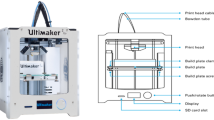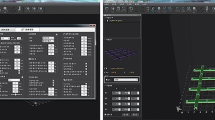Abstract
Fused deposition modeling (FDM) enables the production of prototypes directly from 3D models by laying down consecutive deposits of material to obtain the final geometry. FDM based printing has an advantage over other methods as very complex 3D shapes may be produced in quick time without generation of recyclable waste. In the present work, 3D printing of polymeric material poly lactic acid (PLA) has been performed on cotton-knitted and tulle fabrics to improve the adhesion of polymeric material to fabrics. The process may also be gainfully utilized to improve design patterns and geometry to add style and uniqueness to fashion apparels.
Access provided by Autonomous University of Puebla. Download conference paper PDF
Similar content being viewed by others
Keywords
- Fused deposition modeling (FDM)
- Adhesion force
- 3D printing
- Infill pattern
- z-offset distance
- Printed fabric
1 Introduction
Additive manufacturing is a fast-emerging technology being used for solving problems associated with conventional manufacturing processes. FDM as a part of rapid prototyping technology enables the production of prototypes directly from a three-dimensional model by resting down consecutive layers of material until the final geometry is obtained. These days, different kinds of 3D printers and printing innovations are accessible around the world. First 3D printing innovation was stereolithography (SLA) which was designed by Chuck Hull during the 1980s, yet FDM based 3D printing innovation is modest and most generally utilized when contrasted with other 3D printing advancements. FDM uses a continuous filament of a thermoplastic material which can be fed from a large coil, through a moving heated extruder head. The molten material is forced out of the nozzle and gets deposited on the heated bed layer by layer one over other, thus forming the required 3D shape. As compared to other 3D printing methods, FDM is a relatively slow process. In FDM based 3D printer, there are two types of approaches: first direct type and second is indirect type. In the case of direct approach, the extruder is typically mounted directly on top of the nozzle’s hot end, and therefore, the filament is holed tightly by a wheel and gear. In the case of indirect type approach, the recent end is separated physically from the extruder. Usually, the extruder is mounted anywhere on the inside of the 3D printer. FDM based 3D printing is becoming popular in the fashion industry.
Conventional printing techniques on fabric include dye-based printing and inkjet printing. In dye-based printing, we use engraved design on dye to make impressions on fabric material. In inkjet printing, we use deposition tool for precision droplets of ink on the surface of fabric material. Problem associated with conventional printing technique is that it produces lot of chemical waste which usually gets discarded into the water bodies. Using FDM based 3D printing can overcome this issue as well as provide more precise printing of designs on fabric materials. That is why 3D printed designs on clothes are becoming a point of attraction in fashion shows. Besides making fabric attractive, 3D printing on fabric can also be used to impart functional characteristics such as wear-resistance and stiffness. Due to variety of filaments available for FDM based 3D printing, we can custom print our designs as per requirement, e.g., conductive filament are available, which may print conductive paths on fabric for wearable technologies. Material selection for printing designs on fabrics is also very crucial. Flexible materials like soft PLA, NinjaFlex and PolyFlex filaments are used to print 3D designs [1]. The effect of infill pattern design on the adhesion quality of the first layer has been investigated in the present work. PLA plus filament of 1.75 mm procured from 3DXTECH is used for printing designs. Printing speed, nozzle temperature, printing bed temperature, and first layer height are some key parameters that affect the quality of the print.
2 State of the Art
The conventional printing technique for fabric uses a dye-based method or inkjet printer for printing 2D designs. These methods produce a lot of liquid-based waste which contains harmful chemicals. FDM based printing on fabric has an upper edge over the conventional methods. It enables us to print very complex 3D designs directly on the fabrics. It produces less harmful and recyclable waste which is good for our environment. FDM can be used to 3D print the whole dress or directly print design patterns on the fabric.
Many tests are linked with interactions of textile surface properties on the adhesion strength of printing various polymers [2, 3]. The interactions show that FDM prints on cotton, polyester, wool and viscose may result in great adhesion properties [4, 5]. Further, the z-offset distance between nozzle and printing bed has a significant effect on the measured adhesion force [6]. Various applications of 3D printing on textile fabric are considered for smart and functional textiles which are not possible with the conventional printing processes [7].
Pei et al. examined the adhesion properties of PLA, ABS and nylon filaments printed using a commercial FDM printer onto various woven and knitted fabrics. They printed various 3D structures such as parallel strips, circular rings, circles, and triangular shapes of 1 mm height, Braille characters, articulate parts, functional hooks and latches. PLA show the best results with low warping and higher bonding, print quality and flexural strength. Among the fabrics woven cotton, woven polyester–wool and knit soy, woven polyester–wool had good adhesion properties than other two fabrics [8, 9].
Grimmelsmann et al. extended the study of printing on textile fabrics to examine the impact of the z-offset distance on the adhesion properties of the materials [10]. They reported that physical ‘locking’ between fabrics and printing polymers (PLA and ABS) was the major factor that caused adhesion, not the chemical bonding. Prisca Aude et al. investigated the stress–strain and deformation of PLA material on polyethylene terephthalate. They concluded that platform temperature has a limited role in improving adhesion properties, whereas fiber direction in fabric does contribute to better adhesion characteristics.
First layer of the print is very crucial for adhesion properties. No reference is available in existing literature related to role of infill pattern design. Present work is aimed at determining the effect of varying infill percentage on adhesion property. It also studies the extent of bonding of the first layer on the fabric.
3 3D Printing of Design Pattern on Fabrics
Thin wire of 1.75 mm of PLA is used for 3D printing. A CAD model of circular disc-shape is provided with a hook designed in Creo 2.0 and converted into stereolithographical (.stl) format. G-codes for these STL files are generated by using Slic3r as shown in Fig. 1.
4 Experimental Investigation
Cotton-knitted fabric and tulle net fabric (nylon) have been used in the present investigation. Netted fabrics are selected for better deposition of the fused plastic material deep inside the fabric net as shown in Fig. 2. Process parameters are selected with the help of available literature prior to the investigation for ensuring a better quality of print as given in Table 1. Fabric is placed on the printing bed by means of a heating tape as shown in Fig. 3. Optimum z-offset distances (distance between nozzle and fabric) are crucial to ensure better deposition of molten plastic deep inside the fabric voids. Samples of a circular disc of diameter 30 mm and 3 mm thickness are printed on cotton-knitted fabric and tulle fabric by changing infill patterns of the first layer as shown in Fig. 4.
Infill patterns are varied for the first layer of the print. First layer is crucial for good adhesion between the printed object and the fabric. Slic3r is provided with different types of infill patterns. One sample has been printed on each fabric (tulle and cotton) with each infill pattern as shown in Fig. 5.
5 Results and Discussion
Failure load for each sample until the complete separation of the object from the fabric is investigated by changing the weights on the hook. Failure load for each printed sample (Fig. 6) with different infill design, infill percentage, and fabric is given in Table 2. It is clear that an increase in infill percentage will significantly increase the adhesion property between the printed object and fabric (refer Table 2). A hundred percent infill is not possible in the case of honeycomb pattern due to its design characteristics. Hence, 60% has been chosen as the maximum infill for honeycomb infill patterns.
6 Conclusions
Followings are the major conclusions of the present investigation:
-
The design of the first layer is crucial for better adhesion characteristics of a direct 3D printed object on the fabric material.
-
An increase in infill percentage leads to enhanced adhesive bonding between printed object and the fabric.
-
Rectilinear infill of 60% in case of cotton-knitted fabric gives the best adhesion.
-
Concentric infill of 100% gives the best adhesion for tulle fabric.
Due to greater porosity, the adhesion quality is better in tulle fabric in comparison with the cotton-knitted fabric as infill can deposit deep inside the fabric. Fused deposition modeling-based process may be gainfully utilized to design fashionable patterns and geometry to the apparels to add new style and uniqueness.
References
Tadesse MG, Dumitrescu D, Loghin C, Chen Y, Wang L, Nierstrasz V (2018) 3D printing of NinjaFlex filament onto PEDOT: PSS-coated textile fabrics for electroluminescence applications. J Electron Mater 47(3)
Neuß J, Kreuziger M, Grimmelsmann N, Korger M, Ehrmann A (2016) Interaction between 3D deformation of textile fabrics and imprinted lamellae. In: Proceedings of Aachen-Dresden-Denkendorf, International Textile Conference
Riviera ML, Moukperian M, Ashbrook D, Mankoff J, Hudson SE (2017) Stretching the bounds of 3D printing with embedded textiles. In: Conference on Human Factors in Computing Systems, Denver, Colorado, USA
Korger M, Bergschneider J, Lutz M, Mahltig B, Finsterbusch K, Rabe M (2016) Possible applications of 3D printing technology on textile substrates. In: IOP Conference Series: Materials Science and Engineering, vol 141, no 012011
Sabantina L, Kinzel F, Ehrmann A, Finsterbusch K (2015) Combining 3D printed forms with textile structures—Mechanical and geometrical properties of multi-material systems. In: IOP Conference Series: Materials Science and Engineering, vol 87, no 012005
Döpke C, Grimmelsmann N, Ehrmann A (2016) 3D printing on knitted fabrics. In: Proceedings of 48th IFKT Congress, Mönchengladbach, Germany
Santgar RH, Christine C, Nierstrasz V (2017) Investigation of the Adhesion properties of Direct 3D printing of Polymers and Nanocomposites on textiles: Effect of FDM Printing Process Parameters. Appl Surf Sci 403:551–563
Spahiu T, Grimmelsmann N, Ehrmann A, Shehi E, Piperi E (2017) Effect of 3D printing on textile fabric. In: 1st International Conference Engineering and Entrepreneurship Proceedings (ICEE-2017)
Pei E, Shen J, Watling J (2015) Direct 3D printing of polymers onto textiles: Experimental studies and applications. Rapid Prototyp J 21:556
Grimmelsmann N, Kreuziger M, Korger M, Meissner H, Ehrmann A (2017) Adhesion of 3D printed material on textile substrates. Rapid Prototyp J 24:166
Author information
Authors and Affiliations
Corresponding author
Editor information
Editors and Affiliations
Rights and permissions
Copyright information
© 2021 The Author(s), under exclusive license to Springer Nature Singapore Pte Ltd.
About this paper
Cite this paper
Singh, A., Yadav, P.K., Singh, K., Bhaskar, J., Kumar, A. (2021). Design of 3D Printed Fabric for Fashion and Functional Applications. In: Singari, R.M., Mathiyazhagan, K., Kumar, H. (eds) Advances in Manufacturing and Industrial Engineering. ICAPIE 2019. Lecture Notes in Mechanical Engineering. Springer, Singapore. https://doi.org/10.1007/978-981-15-8542-5_63
Download citation
DOI: https://doi.org/10.1007/978-981-15-8542-5_63
Published:
Publisher Name: Springer, Singapore
Print ISBN: 978-981-15-8541-8
Online ISBN: 978-981-15-8542-5
eBook Packages: EngineeringEngineering (R0)










